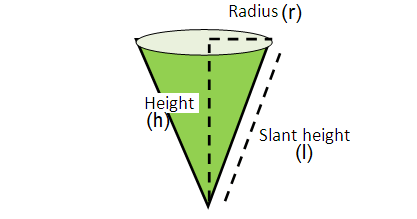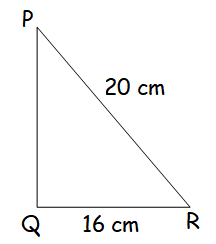CURVED SURFACE AREA AND TOTAL SURFACE AREA OF CONE
Subscribe to our ▶️ YouTube channel 🔴 for the latest videos, updates, and tips.

Curved surface area :
= πrl
Total surface area of
= πr(l + r)
Example 1 :
A right angled triangle PQR where angle Q = 90 degree is rotated about QR and PQ. If QR = 16 cm and PR = 20 cm, compare the curved surface areas of the right circular cones so formed by the triangle.
Solution :

radius of cone = 16 cm
Slant height = 20 cm
If the triangle is rotated about PQ :
Curved surface area = Πrl
= Π ⋅ 16 ⋅ 20
= 320Π cm2
height = √(l2 - r2)
= √(202 - 162)
= √144
h = 12
If the triangle is revolved about QR, then radius will be 12 cm
Curved surface area = Πrl
= Π ⋅ 12 ⋅ 20
= 240Π cm2
So, curved surface area of cone is larger when it is revolved about PQ.
Example 2 :
4 persons live in a conical tent whose slant height is 19 cm. If each person require 22 cm2 of the floor area, then find the height of the tent.
Solution :
Slant height of conical tent = 19 cm
Required area of floor for 1 person = 22 cm2
Area for 4 persons = 22(4) = 88
Πr2 = 88
(22/7) ⋅ r2 = 88
r2 = 88 ⋅ (7/22)
r = 2√7
height = √(l2 - r2)
= √(192 - (2√7)2
= √[361 - 4(7)]
h = √333
h = 18.25 cm
Example 3 :
A girl wishes to prepare birthday caps in the form of right circular cones for her birthday party, using a sheet of paper whose area is 5720 cm2, how many caps can be made with radius 5 cm and height 12 cm.
Solution :
r = 5 cm, height of cap = 12 cm
slant height = √(r2 + h2)
= √(52 + 122)
= √(25 + 144)
h = √169
h = 13
Area of sheet = 5720 cm2
Curved surface area of one cap = Πrl
= (22/7) ⋅ 5 ⋅ 13 -----(1)
Required number of cups = 5720 / [ (22/7) ⋅ 5 ⋅ 13]
= (5720 ⋅ 7)/(22 ⋅ 5 ⋅ 13)
= 28 cups
Example 4 :
The ratio of the radii of two right circular cones of same height is 1:3. Find the ratio of their curved surface area when the height of each cone is 3 times the radius of the smaller cone.
Solution :
r1 = 1, r2 = 3
Height of 1st cone = 3(radius of smaller cone)
= 3(1) = 3
Height of 2nd cone = 3(radius of smaller cone)
= 3(1) = 3
Slant height of 1st cone = √(r2 + h2)
= √(12 + 32)
= √10
Slant height of 1st cone = √(r2 + h2)
= √(32 + 32)
= √18 = 3√2
Curved surface area = Πrl
Πr1l1 : Πr1l1
1√10 : 3 (3√2)
√10 : 9√2
√5 : 9
Example 5 :
Total surface area of a cone whose radius as p/2 and slant height as 2l is:
(a) 2 Π p(l + p) (b) Πp(l + p/4) (c) Π p(1 + p) (d) 2πpl
Solution :
Total surface area of cone = Πr (l + r)
Radius = p/2, slant height = 2l
= Π (p/2) (2l + (p/2)))
Factoring 2 from the bracket, we get
= Π (p/2) x 2(l + (p/4))
= Π p (l + (p/4))
So, option b is correct.
Example 6 :
If the slant height of a cone 12cm and radius of the base is 14 cm, then the total surface area is
Solution :
Slant height (l) = 12 cm
radius (r) = 14 cm
Total surface area = Πr (l + r)
= (22/7) x 14 (12 + 14)
= 22 x 2 x 26
= 1144 cm2
Example 7 :
The radius and height of a cone are in the ratio 4:3. The area of the base is 154 cm2. Find the curved surface area.
Solution :
Radius and height are in the ratio 4 : 3
Radius = 4x and height = 3x
Area of base = Πr2
(22/7) x r2 = 154 cm2
r2 = 154 x (7/22)
r2 = 49
r = 7 cm
4x = 7
x = 7/4
height (h) = 3(7/4) = 21/4
Curved surface area of cone = Πrl
l = √r2 + h2
l = √72 + (21/4)2
= √49 + (441/16)
= √1225/16
l = 35/4
Curved surface area = (22/7) x 7 x (35/4)
= 192.5 cm2
Example 8 :
There are two cones, the curved surface area of one cone is twice that of the other. The slant height of later is twice that of the former. Find the ratio of their radii.
Solution :
Let r, h and l be radius, height and slant height of the smaller cone.
Let R, H and L be radius, height and slant height of the larger cone.
ΠRL = 2(Πrl)
l = 2L
RL = 2( r(2L) )
RL = 4rL
R = 4r
R/r = 4/1
R : r = 4 : 1
So, the ratio between radius of larger and smaller circle is 4 : 1.
Subscribe to our ▶️ YouTube channel 🔴 for the latest videos, updates, and tips.
Kindly mail your feedback to v4formath@gmail.com
We always appreciate your feedback.
©All rights reserved. onlinemath4all.com
Recent Articles
-
10 Hard SAT Math Questions (Part - 38)
Dec 08, 25 12:12 AM
10 Hard SAT Math Questions (Part - 38) -
SAT Math Practice
Dec 05, 25 04:04 AM
SAT Math Practice - Different Topics - Concept - Formulas - Example problems with step by step explanation -
10 Hard SAT Math Questions (Part - 37)
Dec 03, 25 07:02 AM
10 Hard SAT Math Questions (Part - 37)


